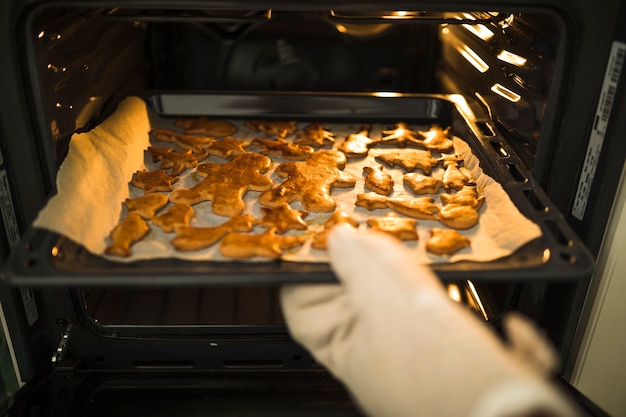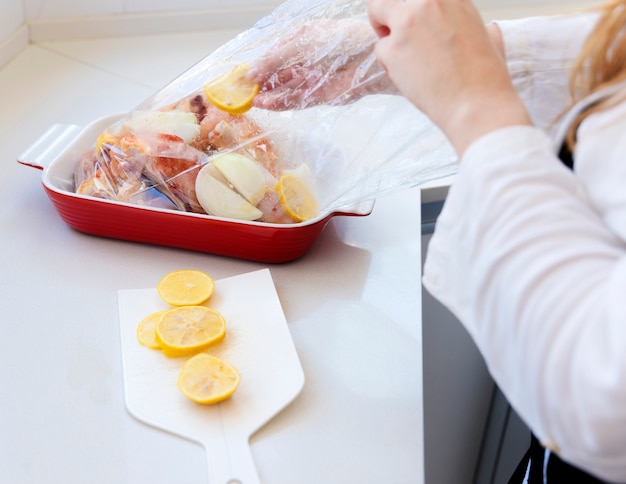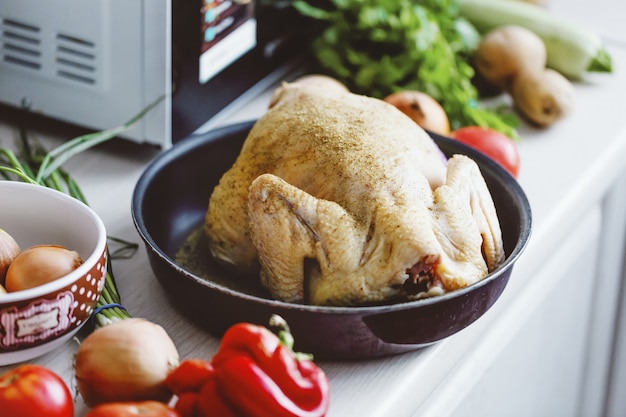(Part 1) Understanding the Basics

Before we dive into the specifics, let's get a grasp on the fundamental principles. It's these basics that will make or break your chicken breast baking experience.
The Importance of Oven Temperature
Why 350 degrees? It's that sweet spot where the heat is consistent and gentle enough to cook the chicken breast evenly without drying it out. Lower temperatures will take longer, while higher temperatures risk burning the outside before the inside is cooked through. 350 degrees provides the perfect balance.
Chicken Breast Thickness: The Key Factor
The thickness of your chicken breasts will be your biggest guide. A thin breast cooks quickly, while a thick one requires more time. A good rule of thumb is to add about 5-7 minutes of cooking time for every additional 1/4 inch of thickness. So, a 1-inch thick breast will need about 20-25 minutes, while a 1.5-inch breast might take 25-30 minutes.
Doneness: Beyond the "Poke and See"
The age-old advice of "poking the chicken to see if the juices run clear" isn't foolproof. While the juices should be clear, this alone isn't a guarantee of safety. The most accurate way to check for doneness is with a trusty meat thermometer. Aim for an internal temperature of 165 degrees Fahrenheit (74 degrees Celsius). This ensures the chicken is cooked through and safe to eat.
(Part 2) Prepping for Success

Just like any good recipe, a little prep work goes a long way.
The Art of Patting Dry
You might think it's a minor detail, but patting your chicken breasts dry with paper towels is a crucial step. Excess moisture creates steam in the oven, which can make your chicken soggy and prevent it from browning nicely. By removing the extra moisture, you're setting the stage for a perfectly crispy skin and a juicy interior.
Seasoning: The Flavor Booster
Don't underestimate the power of seasoning. A simple sprinkle of salt and pepper is always a good starting point, but feel free to get creative. Here are some of my favorite seasoning combinations that elevate the flavor of chicken breast:
- Mediterranean Medley: A blend of dried oregano, thyme, basil, garlic powder, and a pinch of red pepper flakes.
- Spicy Southwest: Smoked paprika, chili powder, cumin, garlic powder, and a touch of cayenne pepper.
- Herby Bliss: Fresh rosemary, thyme, sage, and a drizzle of olive oil.
Remember, you can also incorporate your favorite herbs or spices to create your signature flavor.
(Part 3) The Baking Process: A Step-by-Step Guide

Now that your chicken breasts are prepped and seasoned, it's time to bake them to perfection.
1. Preheat Your Oven
Preheating your oven is essential for even cooking. It ensures that the oven reaches the desired temperature before you introduce the chicken breasts, allowing for consistent heat distribution. Set your oven to 350 degrees fahrenheit (175 degrees Celsius) and give it a good 10-15 minutes to warm up.
2. Choose Your Baking Dish
A baking sheet, a casserole dish, or even a roasting pan will do the trick. Line your chosen dish with parchment paper or foil for easier cleanup and to prevent sticking.
3. Arrange the Chicken
Don't overcrowd the baking dish. Give each chicken breast ample space to cook evenly. If you have multiple breasts, arrange them in a single layer, ensuring that they're not touching. This allows hot air to circulate freely around the chicken, resulting in a more evenly cooked product.
4. Bake and Rotate
Place the chicken breasts in the preheated oven and bake for the estimated time based on their thickness. About halfway through the baking time, rotate the dish 180 degrees. This ensures that the chicken cooks evenly on all sides.
(Part 4) Recognizing Doneness: A Multi-Sensory Approach
Checking for doneness is an art form in itself. You want to ensure that your chicken is cooked through without overdoing it.
The Meat Thermometer: Your Reliable Guide
This is the gold standard for accurate doneness. Insert the thermometer into the thickest part of the chicken breast, making sure to avoid the bone. When the temperature reads 165 degrees Fahrenheit (74 degrees Celsius), your chicken is perfectly cooked.
Visual Cues: A Helpful Indicator
While the thermometer is the most reliable method, your eyes can also offer clues. The chicken breast should be opaque (not translucent) and the juices should run clear, not pink. However, color alone is not a guarantee of doneness, so it's best to use the thermometer as a backup.
(Part 5) The Resting Ritual: A Crucial Step
Once your chicken breasts are cooked through, don't rush to cut them up. Allow them to rest for 5-10 minutes before slicing. This allows the juices to redistribute throughout the meat, resulting in a more succulent and tender final product.
Resting: Unlocking the Juicy Secret
Simply transfer the chicken breasts to a cutting board and cover them loosely with aluminum foil. Let them rest while you prepare any sides or sauces. The resting period will make a noticeable difference in the texture and flavor of your chicken.
(Part 6) Baking Time Chart: A Quick Reference Guide
To help you estimate the perfect baking time for your chicken breasts, I've created this handy chart:
| Chicken Breast Thickness | Baking Time (Minutes) |
|---|---|
| 1 inch thick | 20-25 |
| 1.25 inches thick | 25-30 |
| 1.5 inches thick | 30-35 |
| 1.75 inches thick | 35-40 |
| 2 inches thick | 40-45 |
Remember, these are just estimates. Always use a meat thermometer to confirm doneness and adjust the baking time accordingly.
(Part 7) Flavors Beyond Basic: Elevating Your Chicken
Now that you know the basics of baking chicken breasts, let's explore some flavor variations to make your meal truly special.
Herbed Delight: A Classic Approach
A simple yet effective way to boost the flavor is with herbs. Combine your favorite herbs - rosemary, thyme, sage, or a blend of all three - with a drizzle of olive oil, salt, and pepper. Rub this mixture all over the chicken breasts before baking. The herbs infuse the chicken with a delicious, earthy aroma and a burst of flavor.
Lemon-Garlic Power: Tangy and Aromatic
For a bright, zesty flavor, try a lemon-garlic marinade. Mix minced garlic, lemon zest, lemon juice, olive oil, salt, and pepper. Pour this marinade over the chicken breasts and allow them to marinate for at least 30 minutes before baking. The lemon juice tenderizes the chicken, while the garlic adds a pungent aroma that's simply irresistible.
Honey-Soy Glaze: Sweet and Savory
For a sweet and savory twist, try a honey-soy glaze. Combine honey, soy sauce, sesame oil, ginger, and garlic. Brush this glaze over the chicken breasts during the last 10-15 minutes of baking. The glaze creates a beautiful, caramelized crust and adds a delicious, complex flavor.
(Part 8) FAQs: Your Chicken Breast Baking Questions Answered
I get it. You have questions. Here are some common inquiries and their detailed answers:
1. Can I bake chicken breasts in a foil packet?
Absolutely! Baking chicken breasts in a foil packet is a great way to lock in moisture and create a tender, flavorful result. Simply place the chicken breast in a piece of foil, add your favorite seasonings, and seal it tightly. Bake at 350 degrees Fahrenheit (175 degrees Celsius) for about 20-25 minutes, or until the internal temperature reaches 165 degrees Fahrenheit (74 degrees Celsius).
2. How can I prevent my chicken breasts from drying out?
Preventing dryness is key to a juicy, flavorful chicken breast. Here are some tips:
- Pat dry before baking: This prevents excess moisture from building up in the oven.
- Use a meat thermometer: This ensures the chicken is cooked through without overcooking it.
- Don't overcook: Check the chicken frequently, especially towards the end of baking time.
- Rest after baking: This allows the juices to redistribute throughout the meat, making it more tender.
- Use a marinade: Marinating the chicken in advance can help to keep it moist.
3. Can I bake chicken breasts with other ingredients?
Absolutely! Chicken breasts are incredibly versatile. They pair well with vegetables, such as broccoli, asparagus, peppers, potatoes, onions, and carrots. Simply arrange the vegetables around the chicken breasts in the baking dish and bake until everything is cooked through. Remember to adjust the baking time accordingly based on the thickness of the vegetables.
4. What happens if I overcook my chicken breasts?
overcooked chicken breasts will be dry and rubbery. If you notice that your chicken is getting too brown or the juices run clear but the meat feels dry, take it out of the oven immediately. While not ideal, you can still use overcooked chicken breasts in dishes like chicken salad or soups.
5. Can I freeze baked chicken breasts?
Yes, you can freeze baked chicken breasts for up to 2-3 months. Let them cool completely, wrap them tightly in plastic wrap or aluminum foil, and store them in a freezer-safe bag. When you're ready to use them, thaw them in the refrigerator overnight and reheat them in the oven or microwave.
(Part 9) From Beginner to Chicken Breast Expert
Mastering the art of baking chicken breasts is a journey of discovery. With a little practice and these tips and tricks, you'll be crafting perfect chicken breasts that are juicy, flavorful, and a testament to your culinary skills.
So, gather your ingredients, preheat your oven, and get ready to impress yourself (and your loved ones) with the delicious results of perfectly baked chicken breasts. Happy cooking!
Everyone is watching

Perfect Rice Every Time: The Ultimate Guide to Cooking Rice
Cooking TipsAs a self-proclaimed foodie, I've always been a bit obsessed with rice. It's the foundation of countless cuisi...

Prime Rib Roast Cooking Time Chart: Per Pound Guide
Cooking TipsPrime rib roast. Just the name conjures images of lavish dinners, crackling fires, and hearty laughter. It’s ...

How Long to Bake Potatoes in the Oven (Perfect Every Time)
Cooking TipsBaked potatoes are a staple in my kitchen. They're incredibly versatile, delicious, and surprisingly easy to m...

The Ultimate Guide to Cooking Asparagus: Tips, Techniques, and Recipes
Cooking TipsAsparagus. The mere mention of this spring delicacy conjures up images of vibrant green spears, crisp and burs...

Ultimate Guide to Cooking the Perfect Thanksgiving Turkey
Cooking TipsThanksgiving. Just the word conjures up images of overflowing tables laden with delicious food, the scent of r...
